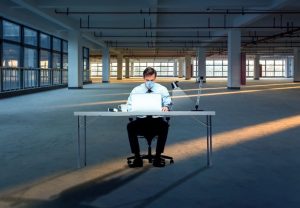So, What Exactly Does The Current Workplace Environment Look Like?

As a recruitment agency we speak to both clients and candidates on a regular basis, and it’s still unclear even two and a half years since the pandemic, when businesses were forced to adapt their working practices, whether a full return to the office, hybrid or remote working has been fully established in the majority of companies. So, is there a definitive answer leading us into a New Year?
Business leaders and HR professionals have been working hard to establish a system that works best for their organisation, as well as individual employees, not an easy balancing act, considering many employees have re considered their work life balance and what is essential to their wellbeing in the long term.
So why are so many companies still searching for the solution, years later? Is it because they are seeking a one size fits all resolution or has the modern way of working become a far less linear path, or perhaps there is still no right answer, considering the current economic climate and that Covid is still causing concerns and companies are still cautious about bringing their staff together in one location?
WHAT NEEDS CONSIDERATION MOVING FORWARD?
If you start to consider the health of a good business there are different criteria to satisfy, that being those of the client/customer and that of the foundation of the organisation – the staff! Without those clients there is no reason to get up and get motivated, but more importantly, no clients, no revenue.
On the other side of the coin is your teams needs, what encourages them to work hard for you, turn up, work those extra hours to complete a presentation or a project?
Obviously both elements are absolutely vital to each and every business, and both need consideration when ensuring you get the Office of the future working hard for you. Many employees are now seeking flexibility and home working has become a term used far wider than it ever used to be, with more and more people now equipped to work remotely without that long and painful commute to the office.
There are also third parties to consider, who also help to keep a business moving, such as creative agencies, data analysts and business development consultants. Face to face meetings is often far more productive and should be taken into consideration when finalising your overall workplace plans.

SO, IS THERE A CONCLUSIVE ANSWER?
Whilst flexibility is always a consideration, consistency is also essential, so perhaps it’s time for businesses to make some hard decisions, that may not suit everyone, but will gain a stronger picture in terms of how an organisation is going to function moving forwards.

Accommodating every single person in an organisation is unrealistic and companies need to take control and draw up a picture of what the new look of the office environment is going to be and work to create a workplace future that everyone wants to be a part of.
Flexibility needs to come from both sides, the company, and the employee. Leaders need to offer some degree of home working if it works for both parties, and employees need to start accepting that they need to be more fluid with their time and that they may need to begin commuting again. Of course, at this stage there is a choice, for some employees this may no longer work for them, and they may need to reconsider their options. Companies need to be prepared that there may be resignations; however, it is the long-term office environment vision that needs to remain top of mind.
IS THERE A LONG-TERM IMPACT ON EMPLOYEE WELFARE HAVING LESS FACE-TO-FACE COMMUNICATION?

Another reason it is essential to think long term is that with more virtual communication with our colleagues, clients, and third-party agencies we may all become so used to working in isolation, we forget the values of working together in face-to-face teams, the breadth of knowledge and creative thinking that can give us, by bouncing ideas off each other, and learning from those with a greater depth of experience.
Remember too that many new intakes began working during the pandemic and have never physically had the experience of working in an office at all, and therefore have nothing to compare to their current working status with. Is this truly a healthy learning and growth experience environment?
Maintaining that crucial element of community, is a basis on which successful teams and working relationships can thrive. Identifying areas for personal improvement, people that may inspire you to do better and grow, can be gained from seeing first hand how leaders, peers and external contacts resolve issues or draw teams together to achieve incredible results can’t be gained through a computer screen.
As much as many may wish to continue working from home, and aren’t pushing for a change in these circumstances, none of us may yet know the impact these decisions may have on businesses or individuals in the long run. Hence why it is essential to do the groundwork by liaising with all your employees and
then taking time to reflect on responses, but make decisions that benefit all parties, for personal and professional growth.
FLEXIBILITY IS A TWO-WAY THING
The only way organisations can successfully consider hybrid working, if this is the direction you maybe considering is to expect some flexibility in return. Set days of working in the office may suit an individual, but not a full team. So, there are definitely many elements that need consideration prior to rolling out your long-term plan. Companies need to be bold in their decision making and make it clear to all concerned the direction in which it is going with regards to the day-to-day office environment.
Perhaps we have all settled into “comfortable”, but without clear direction, if it’s not broken then why fix it mode? However, companies do need to be absolutely clear on their vision for what their office environment will be, their working policy and mandated expectations from their employees, it’s time to fix this limbo and be upfront with regards to “how we ALL work”.
Without a clear direction or guidance on what the future holds for your company, how can you expect current or future employees to know whether it is a long-term environment they wish to work in?
WILL IT BE THE GOLDEN AGE OF HYBRID WORKING?
There is no question we have all experienced the shake up of the office culture since Covid-19 became so prevalent in all our lives. More and more companies have taken decisions to change the surroundings including scrapping personal desks and introducing more hot desking, meeting rooms have been further equipped to hold hybrid meetings, with more screens, microphones, and cameras than ever before. There is also a sense that more and more employees would rather seek a new role than return to the office environment and the extended commute.

Perhaps the key is for the office environment to become a more collaborative space, where brainstorming meetings and more focused gatherings happen, rather than a general day to day workspace.
There are also the physical consequences of what size of office is required now with so many potential changes. Since hybrid working has proven its worth and, in many circumstances, highlighted that not all workers are required to be in one place at the same time, it begs the question “can companies reduce their overheads and costs” by making hybrid working a permanent fixture?
On the flip side did we ever think we would here the words “Zoom Fatigue”? Constant online meetings and navigating the creation of a home office do not always come easy and have we considered the negative effects of the digital challenges on both physical and mental health? Wouldn’t we rather hear the voices of our colleagues in person though, than through the speaker of a laptop? As yet we have no comprehension of the impact of a workday spent online has on our personal wellbeing and work relationships. Are we heading in a direction of becoming an Avatar of our former selves?
If we were to review the archives of days gone by and working environments, we will clearly see that change in working conditions has been ever evolving and that change is inevitable, whether for health & safety reasons, such as a pandemic, or the desire to create a more effective solution to be more productive.
Different people require different environments to work effectively, and the types of tasks undertaken require differing conditions. If nothing else the result of the pandemic on the office environment has opened up a full discussion on what the future of the office looks like and ignoring that it’s time for change is most definitely not the answer.
If the office of the future is going to attract people to leave the comfort of their own home, turn their engines on on a cold morning and defrost their cars, or run for the train only to squeeze in the door and find themselves nose to nose with the passenger next to them, then leaders need to make a clear and strong case in terms of the purpose of the office and the type of work that can be best done in person.
Rethinking the physical space also needs to be part of the plan, ensuring employees can soften the problems of returning to long commutes, less time with their families/pets etc and the daily environment they have created. Companies need to understand that very few of us want to return to the workplace of 2019, and that expectations of work have totally changed in the last two years, and therefore the offices need to reflect this too, and be an engaging environment worth leaving the house for.






